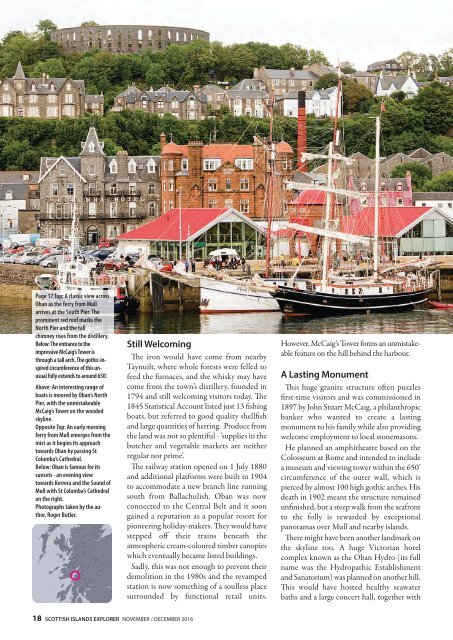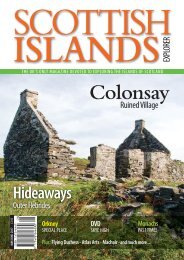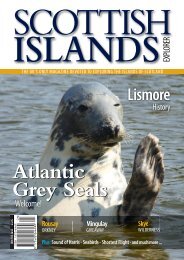Create successful ePaper yourself
Turn your PDF publications into a flip-book with our unique Google optimized e-Paper software.
Page 17 Top: A classic view across<br />
Oban as the ferry from Mull<br />
arrives at the South Pier. The<br />
prominent red roof marks the<br />
North Pier and the tall<br />
chimney rises from the distillery.<br />
Below: The entrance to the<br />
impressive McCaig’s Tower is<br />
through a tall arch. The gothic-inspired<br />
circumference of this unusual<br />
folly extends to around 650’.<br />
Above: An interesting range of<br />
boats is moored by Oban’s North<br />
Pier, with the unmistakeable<br />
McCaig’s Tower on the wooded<br />
skyline.<br />
Opposite Top: An early morning<br />
ferry from Mull emerges from the<br />
mist as it begins its approach<br />
towards Oban by passing St<br />
Columba’s Cathedral.<br />
Below: Oban is famous for its<br />
sunsets - an evening view<br />
towards Kerrera and the Sound of<br />
Mull with St Columba’s Cathedral<br />
on the right.<br />
Photographs taken by the author,<br />
Roger Butler.<br />
Still Welcoming<br />
e iron would have come from nearby<br />
Taynuilt, where whole forests were felled to<br />
feed the furnaces, and the whisky may have<br />
come from the town’s distillery, founded in<br />
1794 and still welcoming visitors today. e<br />
1845 Statistical Account listed just 13 fishing<br />
boats, but referred to good quality shellfish<br />
and large quantities of herring. Produce from<br />
the land was not so plentiful - 'supplies in the<br />
butcher and vegetable markets are neither<br />
regular nor prime'.<br />
e railway station opened on 1 July 1880<br />
and additional platforms were built in 1904<br />
to accommodate a new branch line running<br />
south from Ballachulish. Oban was now<br />
connected to the Central Belt and it soon<br />
gained a reputation as a popular resort for<br />
pioneering holiday-makers. ey would have<br />
stepped off their trains beneath the<br />
atmospheric cream-coloured timber canopies<br />
which eventually became listed buildings.<br />
Sadly, this was not enough to prevent their<br />
demolition in the 1980s and the revamped<br />
station is now something of a soulless place<br />
surrounded by functional retail units.<br />
However, McCaig’s Tower forms an unmistakeable<br />
feature on the hill behind the harbour.<br />
A Lasting Monument<br />
is huge granite structure oen puzzles<br />
first-time visitors and was commissioned in<br />
1897 by John Stuart McCaig, a philanthropic<br />
banker who wanted to create a lasting<br />
monument to his family while also providing<br />
welcome employment to local stonemasons.<br />
He planned an amphitheatre based on the<br />
Colosseum at Rome and intended to include<br />
a museum and viewing tower within the 650’<br />
circumference of the outer wall, which is<br />
pierced by almost 100 high gothic arches. His<br />
death in 1902 meant the structure remained<br />
unfinished, but a steep walk from the seafront<br />
to the folly is rewarded by exceptional<br />
panoramas over Mull and nearby islands.<br />
ere might have been another landmark on<br />
the skyline too. A huge Victorian hotel<br />
complex known as the Oban Hydro (its full<br />
name was the Hydropathic Establishment<br />
and Sanatorium) was planned on another hill.<br />
is would have hosted healthy seawater<br />
baths and a large concert hall, together with<br />
18 SCOTTISH ISLANDS EXPLORER NOVEMBER / DECEMBER <strong>2016</strong>















